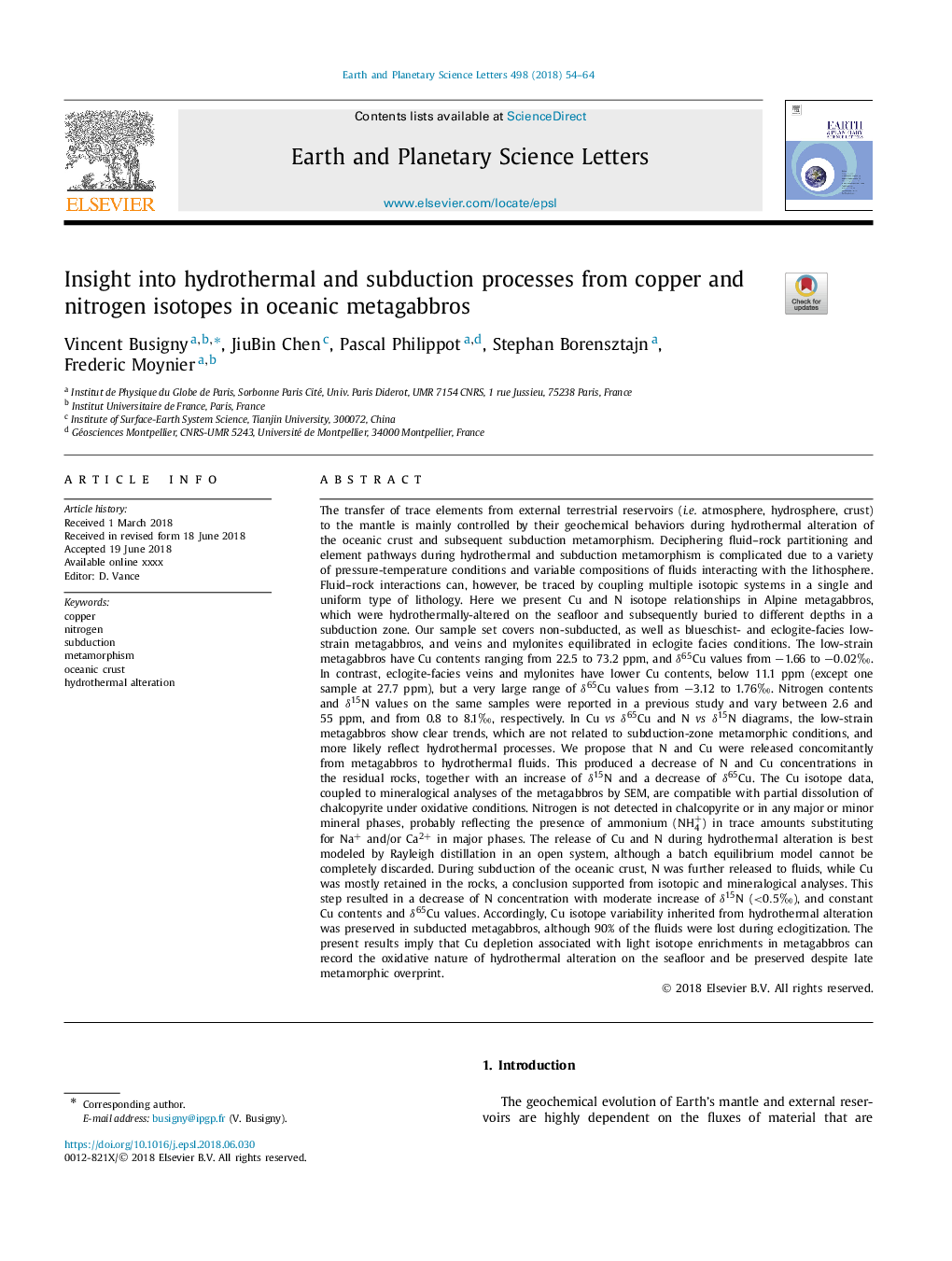| کد مقاله | کد نشریه | سال انتشار | مقاله انگلیسی | نسخه تمام متن |
|---|---|---|---|---|
| 8906706 | 1634658 | 2018 | 11 صفحه PDF | دانلود رایگان |
عنوان انگلیسی مقاله ISI
Insight into hydrothermal and subduction processes from copper and nitrogen isotopes in oceanic metagabbros
ترجمه فارسی عنوان
نگاهی به فرآیندهای هیدروترمال و فرایند فرآوری از ایزوتوپهای مس و نیتروژن در متاگابروهای اقیانوسی
دانلود مقاله + سفارش ترجمه
دانلود مقاله ISI انگلیسی
رایگان برای ایرانیان
کلمات کلیدی
موضوعات مرتبط
مهندسی و علوم پایه
علوم زمین و سیارات
علوم زمین و سیاره ای (عمومی)
چکیده انگلیسی
The transfer of trace elements from external terrestrial reservoirs (i.e. atmosphere, hydrosphere, crust) to the mantle is mainly controlled by their geochemical behaviors during hydrothermal alteration of the oceanic crust and subsequent subduction metamorphism. Deciphering fluid-rock partitioning and element pathways during hydrothermal and subduction metamorphism is complicated due to a variety of pressure-temperature conditions and variable compositions of fluids interacting with the lithosphere. Fluid-rock interactions can, however, be traced by coupling multiple isotopic systems in a single and uniform type of lithology. Here we present Cu and N isotope relationships in Alpine metagabbros, which were hydrothermally-altered on the seafloor and subsequently buried to different depths in a subduction zone. Our sample set covers non-subducted, as well as blueschist- and eclogite-facies low-strain metagabbros, and veins and mylonites equilibrated in eclogite facies conditions. The low-strain metagabbros have Cu contents ranging from 22.5 to 73.2 ppm, and δ65Cu values from â1.66 to â0.02â°. In contrast, eclogite-facies veins and mylonites have lower Cu contents, below 11.1 ppm (except one sample at 27.7 ppm), but a very large range of δ65Cu values from â3.12 to 1.76â°. Nitrogen contents and δ15N values on the same samples were reported in a previous study and vary between 2.6 and 55 ppm, and from 0.8 to 8.1â°, respectively. In Cu vsδ65Cu and N vsδ15N diagrams, the low-strain metagabbros show clear trends, which are not related to subduction-zone metamorphic conditions, and more likely reflect hydrothermal processes. We propose that N and Cu were released concomitantly from metagabbros to hydrothermal fluids. This produced a decrease of N and Cu concentrations in the residual rocks, together with an increase of δ15N and a decrease of δ65Cu. The Cu isotope data, coupled to mineralogical analyses of the metagabbros by SEM, are compatible with partial dissolution of chalcopyrite under oxidative conditions. Nitrogen is not detected in chalcopyrite or in any major or minor mineral phases, probably reflecting the presence of ammonium (NH4+) in trace amounts substituting for Na+ and/or Ca2+ in major phases. The release of Cu and N during hydrothermal alteration is best modeled by Rayleigh distillation in an open system, although a batch equilibrium model cannot be completely discarded. During subduction of the oceanic crust, N was further released to fluids, while Cu was mostly retained in the rocks, a conclusion supported from isotopic and mineralogical analyses. This step resulted in a decrease of N concentration with moderate increase of δ15N (<0.5â°), and constant Cu contents and δ65Cu values. Accordingly, Cu isotope variability inherited from hydrothermal alteration was preserved in subducted metagabbros, although 90% of the fluids were lost during eclogitization. The present results imply that Cu depletion associated with light isotope enrichments in metagabbros can record the oxidative nature of hydrothermal alteration on the seafloor and be preserved despite late metamorphic overprint.
ناشر
Database: Elsevier - ScienceDirect (ساینس دایرکت)
Journal: Earth and Planetary Science Letters - Volume 498, 15 September 2018, Pages 54-64
Journal: Earth and Planetary Science Letters - Volume 498, 15 September 2018, Pages 54-64
نویسندگان
Vincent Busigny, JiuBin Chen, Pascal Philippot, Stephan Borensztajn, Frederic Moynier,
